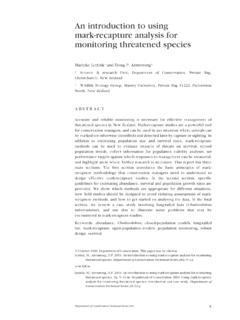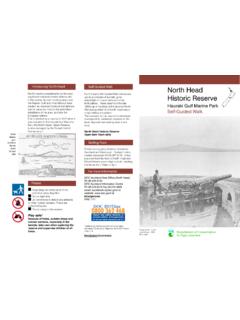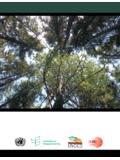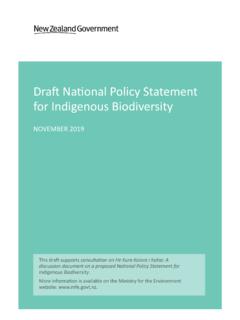Transcription of The importance of invertebrate biodiversity: An Otago ...
1 ISSN 1171-9834 1994 Department of ConservationReference to material in this report should be cited thus:Patrick, B., importance of invertebrate biodiversity : an Otago Conservancy Advisory Science Notes No. 53,Department of Conservation,Wellington. by: Otago : NZMSTHE importance OF invertebrate BIODIVERSITYAN Otago CONSERVANCY REVIEWB rian PatrickOtago Conservancy, Box 5244 DunedinINTRODUCTIONA lthough this review focuses on the invertebrates of Otago , its main objective is to stress theimportant role invertebrates play in natural processes within all parts of New Zealand and thecontribution that New Zealand invertebrates make to global comprise the bulk of animal species diversity in all terrestrial habitats, includingfreshwater, within Otago the estimated 20 000 invertebrate species presentinNew Zealand, 60% or about 12 000 are found naturally in Otago Conservancy (Table 1).
2 (These figures include only known species. Kuschel (1990) estimates our beetle fauna at 10 500species and total insect fauna at 42 000 alone.) As less than 2% of these are introduced, thegreat majority are native the familiar birds we see, the familiar insects aregenerally native species such as the huhu beetle(Prionoplus reticularis)(the largest nativebeetle), porina moths (Wiseanaspp.) and bluebottle fly(Calliphora quadrimaculata).Thoseexotic species we have are often confined to suburban or pastoral settings. Invertebratesincluding insects are New Zealand's major contribution to world biodiversity and are asimportant as the kiwi or tuatara. Every part of Otago Conservancy has a particular assemblageof native invertebrates , which are vital components of the functioning ecosystem of that the New Zealand invertebrate fauna is noted for its high rate of endemism (at least 90%)and is among the three highest in the world for a discrete area, the others being Madagascar andHawaii (Dugdale, 1988).
3 However, the number of species restricted to Otago could be expectedto be much lower. I estimate 5-10% of the invertebrates of Otago are only found there. Thisreflects the variety of habitats available in Otago which in turn is determined by both the natureof and history of the basement rocks of Otago . The species richness of Otago invertebratesstrongly reflects both the long and complex geological history of Otago and the existence of avery wide range of present day environments including the driest, among the wettest, highest,coldest and hottest parts of New Zealand. Otago landforms are composed of some of the oldestrocks in New Zealand and have the oldest preserved land 1 invertebrate Class orApproximate Number of% of New ZealandInsect OrderSpecies in OtagoFaunaSpiders (Arachnida)100034 Land snails (Mollusca)30040 Beetles (Coleoptem)310062 Flies (Diptera)160064 Wasps (Hymenoptera)700?
4 Moths (Lepidoptera)122061 Caddis (Trichoptera)11052 Others3970?Total12 00060 GEOLOGICAL BACKGROUNDG eologically, Otago has been divided into the following:1 The Haast schist core stretches from the eastern coast, where Pliocene volcanoes haveerupted through the core, to the West Coast where it merges with the Fiordland granitecomplex. Low grade schist is mapped to the Waitaki River but in reality it is a transitionarea of semi-schist grading into the Canterbury the south it meets theancient Southland greywackes on the Southland Syncline and in the North Otago limestone of Oligocene/Eocene age covering the schist basement with Eocenevolcanoes along the Southland greywacke of Triassic/Jurassic age in the Some areas of Torlesse greywackes in North Otago , more typical of then Otago consists of ancient metamorphosed schist worn down to a peneplain inthe Cretaceous and Tertiary eras then uplifted quite recently (five million years ago)
5 , but withan older flora and fauna that through its present distributions has left a trace of formergeography and stratigraphic features of the schist bedrock, and soils that have developed there, areunique to Otago , such as the exhumed tors, sarsen stones and saltpans. They are all strikingfeatures of the Otago landscape and their attendant specialised flora and fauna is also unique broad summits of the Central Otago mountains are particularly well vegetated,consisting of cushionfield-tundra, dwarf shrubland, rich snowbanks, fellfield, grasslands andmany tarns, seepages and features of the basin systems between the manymountain ranges are river terraces of semi-natural vegetation with short grasses and nativecushion plants. Also present are areas of sandy soils containing a distinctive assemblage ofplants and insects, and numerous wetlands including ephemeral wetlandscharacteristically have a range of spring annual plants present, together with a distinctive FEATURES OF INVERTEBRATES1 invertebrates are small and can utilise very small resource large number ofspecies can share the same habitat, some of which may have very large Most species have annual life cycles and depend on suitable breeding conditions beingpresent every year at the appropriate time.
6 For species with more than one generation ayear these requirements are repeated through the year. Fewer species have generationslonger than one year, even fewer both long and invertebrates in general have no long term resting stage so they cannot easily overcomeeven short periods of invertebrates have complex life cycles and each part of the life cycle has specific habitatrequirements that must be met within the limits of mobility for the life stage of Most invertebrates have very limited means of dispersal and are therefore very slow atrecolonisation of sites from where they have been invertebrates are cold blooded and therefore dependent on external heat for , warm surfaces such as bare ground, rock faces and tree trunks areimportant for their OF NEGLECTED HABITATSMany habitats that are important for invertebrates for part or all of their life cycle are generallyunrecognised and therefore often unprotected in the reserve system.
7 Some important points are:1 Minor features of a site may be a vital feature to some of the invertebrates of that Neglected features such as dead wood (at all stages), bare ground, bare rock surfaces, tidalwood, dead algae and river shingle are very important for a great many invertebratespecies at some stage of their life Juxtaposition of habitats is a key factor in determining the suitability of sites for manyinvertebrates as each life cycle stage can require different Ideal sites for invertebrates contain a variety of habitats with a gradual transition Most invertebrate species depend on common plants not rare FEATURES OF NEW ZEALAND invertebrate FAUNAThe New Zealand invertebrate fauna is markedly different from that of other areas on earth andthis gives New Zealand a special role and mandate in global biodiversity conservation special features are as follow:1 High rate of endemism as species level.
8 > 90% for most Several endemic families of invertebrate (Mystacinobiidae - batflies, Mnesarchaeidae -moths, Synthetonychidae - harvestmen).3 The most popular host plants are those that are cold adapted, ie, southern, alpine or both,or are genera that are found from coastal to alpine habitats, eg,Hebe/Leonohebe, Olearia,Muehlenbeckia, Nothofagus, Richer alpine fauna (60 % of species) than lowlands although lowlands cover 60 % ofcountry (perhaps a result of human introductions or habitat modification).5 Beetle,moths, flies and true bugs dominate in terms of species Hibernation non-existent - just slow their life cycles down as food An especially rich land snail fauna (mostly in leaf litter), moth fauna and aquatic A disproportionate number of heavy bodied insects (weta, giant weevils, hepialid moths,etc) that are often flightless in normally flighted MANAGEMENTA site managed effectively for native invertebrates is usually a site managed well for nativevegetation, other fauna and natural processes because invertebrates are effectively the lowestcommon denominator in communities.
9 Some general points are as follow:1 The larger and more ecologically diverse a site the Habitat continuity and structural variation of the vegetation are A site should be managed for its strengths not maximum Promotion of all stages of vegetation succession enhances a site for invertebrates , thereforerotational management is "Creative" management such as tree planting and pond digging should not be undertakenwithout careful thought on what is being destroyed in the importance OF INVERTEBRATESIn Otago , as elsewhere in New Zealand, invertebrates are found from the coast to the nival(above summer snowline) zone on the highest mountains. They are not only characteristic ofall the plant communities present, but by their differential grazing of various plants stronglydetermine the plant species seed and seedling eating habits are important inmaintaining the integrity of communities by eliminating intruders which would usually arrivein very small numbers compared to the large number of seeds/seedlings produced by the this way, intact native communities can resist invasive weeds, unless the process isdisrupted by man in the form of tracking, burning, stock grazing, etc.
10 Table 2 summarises theimportance of invertebrates to sustaining plant are important in the soil for aeration, decomposition of dead plant material tocreate an organic layer and consequent release of nutrients which are then available for livingplants, and assisting with formation of soil structure. In the absence of leaf litter feeders ourgrasslands, shrublands and forests would be rapidly choked up with litter and die within , together with some micro-organisms such as fungi, are the only terrestrial organismsable to break down cellulose, the basic material of plants. Higher animals would also disappearquickly in the absence of these recycling invertebrates and the world would quickly return tothat of a billion years ago when only bacteria and algae invertebrates , apartfrom being prey for native fish, are important in the flow of energy in water systems.


















